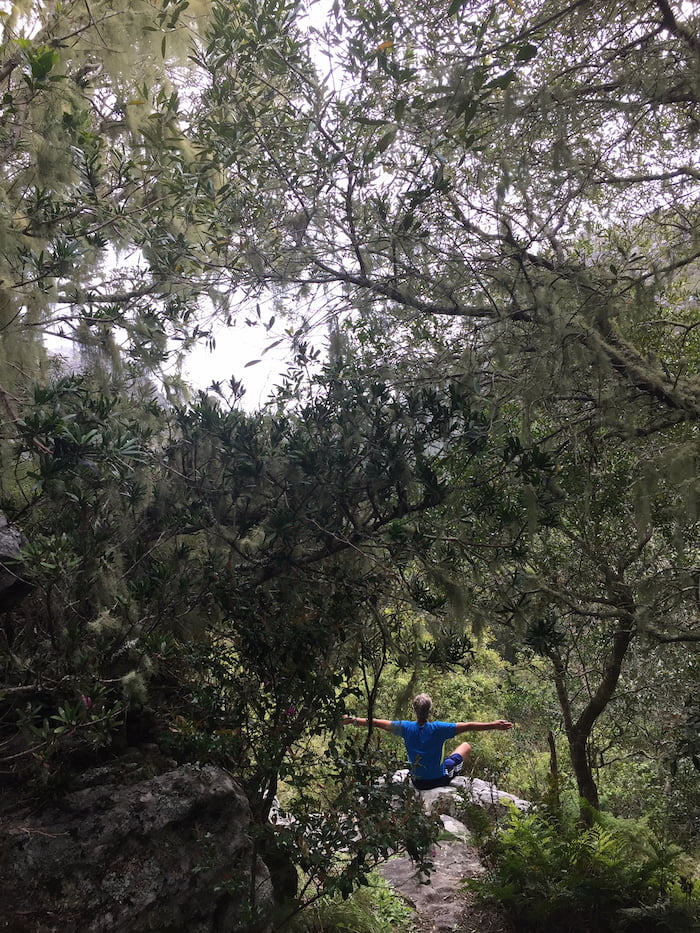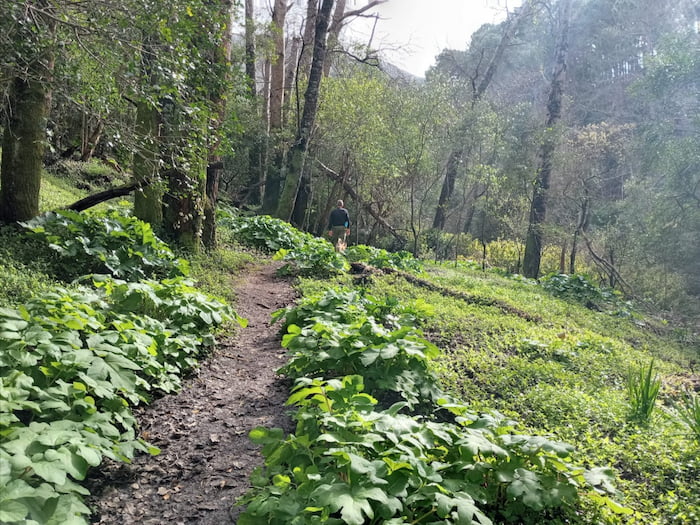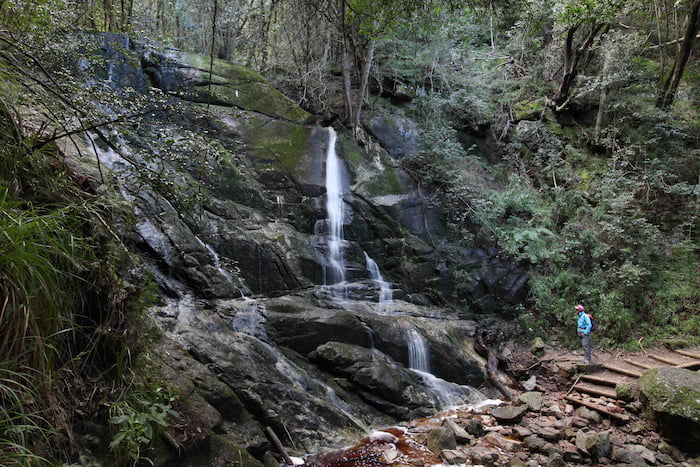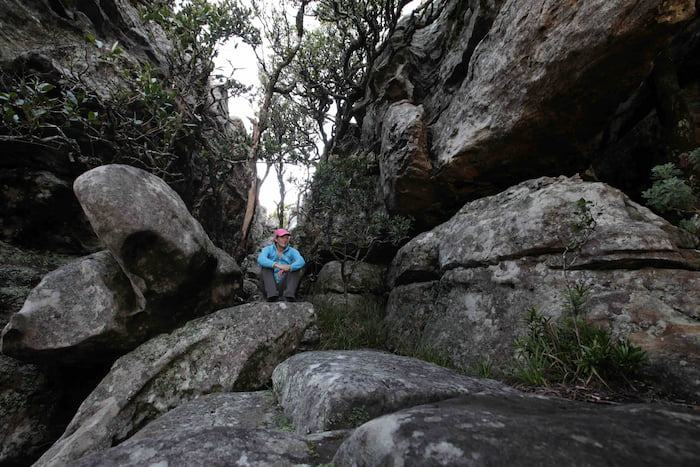The trees can talk back
It’s an old joke that talking to the trees doesn’t mean you’re insane – it’s just when they start talking back that you need to worry. Well, biologist George David Haskell – in his 2017 book The Songs of Trees – describes how trees sing and compares walking into a forest to stepping into a church or temple. He explains that ‘understanding that nature is a network is the first step in hearing trees talk,’ so – if we can learn how to listen – we can hear trees talk. Forests are havens of harmonious white noise, and also of a subtle and pleasing scent. And we all learned in school how they produce oxygen. So it should hardly be surprising that we feel good when we walk among the trees.

Orange Kloof
How forest bathing works
In Japan, shinrin-yoku has been quite formalised, and you can even do guided forest bathing sessions. And in California, they even have forest bathing clubs, but, really, it’s very simple. And don’t let the term ‘bathing’ mislead you. It’s not about stripping down and dancing naked among the trees. Forest bathing is as simple as taking a gentle stroll in the woods – clothes not essential, but very strongly recommended.
What makes it different from a simple walk is your focus – it’s not about clocking your 10,000 steps, and it’s not about Instagramming a selfie in front of Cecelia Waterfall so you don’t have to confess you are the only Capetonian who has not slogged up there. It’s about the trees, the air, the wind and the earth. There is even a school of thought that recommends walking barefoot in nature so you can ‘ground’ yourself, but that’s another story. It’s about communicating with the trees, acknowledging them as fellow sentient beings – and you can hug them if you like, but it’s not an away-with-the-fairies endeavour. And, yes, while clothes may be optional, headphones are a definite no-no. How can you possibly hear the trees singing if you’ve got hip hop plugged into your ears?

Die Hel - by Jennifer Stern
Some great Table Mountain forest bathing spots
A. De Hel
This dense remnant patch of protected forest is conveniently nestled between Constantia Main Road and Southern Cross Drive. It’s a level stroll along the edge of the forest but, if you want to really immerse yourself in the tangled greenery, you should take the slightly steeper path down to the stream. This is a really accessible forest bathing option both because it is close to the road, and because it’s not a very strenuous walk. The steeper bits can be slippery in wet weather, but there are well-maintained steps. Dogs are allowed on leash.
B. Orange Kloof

Contour Path near Skeleton Gorge
C. Contour Path
If you want to learn more about the Cape’s Afro-montane forest, the section of the Contour Path between Kirstenbosch and Newlands Forest is tops. The well-trodden trail winds past Nursery and Skeleton Ravines and along the cool, moist, eastern slopes of Table Mountain to Newlands Forest and beyond. Many of the giant hardwoods – Assegai (Curtisia denata), Hard Pear (Olinia ventosa), Cape Beech (Rapanea melanophloeos) and, in the streams, Rooi-Els (Cunonia capensis) – bear helpful identification tags. There are lots of pools and fallen logs and, at the intersection of the Contour Path and Newlands Ravine, a lovely octagonal bench where you can sit and soak it all up.
This is a good year-round trail: the forest offers shelter from the hot sun in the summer, but it is particularly lovely in winter when waterfalls tumble down the ravines, and colourful fungi adorn the dead branches. Dogs on leashes are allowed along the Contour Path with a My Activity Permit. They may enter Kirstenbosch and access the Contour Path only via the Rycroft gate. Dogs are not allowed at the Newlands Forest picnic site so plan your route accordingly.

Spes Bona Forest
D. Spes Bona and Echo Valley
This short, accessible circuit incorporates two wonderful stretches of indigenous forest as well as a lovely natural amphitheatre above Kalk Bay. The trail starts at Ou Kraal, climbing gently up the Old Mule Trail until signs direct you to the wooded Spes Bona Valley, a magical world of twisted boughs, delicate lichens and twittering birds. Continue up, mainly on boardwalks, past magnificent specimens of South Africa’s national tree, the Broadleaved, or Real, Yellowwood (Podocarpus latifolius) as well as Cape Beech or Boekenhout (Rapanea melanophloeos), Assegai (Curtisia dentata) and milkwoods (Sapotaceae) to a conveniently placed bench. Once out of the forest you re-emerge into fynbos and scramble over rocks to the top of the plateau. Stop to take in the views over False Bay before descending, via a lovely sandy bowl known as the Amphitheatre, through the equally enchanting Kroon se Bos (Amazon Forest) of Echo Valley. Just before you leave the forest there’s a lovely octagonal bench, where you may feel inclined to sit and enjoy your last moments under the canopy. If you have a My Activity Permit you can take your dog on a leash.

Tranquillity Cracks
E. Tranquillity Cracks
This circular, moderately strenuous hike takes in some of the few remaining stands of forest on Table Mountain’s drier, western flanks.
From the trailhead at Theresa Avenue follow the Pipe Track to its end where the path goes beneath the cliffs at the base of Slangolie Buttress. Then once around the buttress, the path climbs up Corridor Ravine to the top of the mountain – the Back Table. Turn left and follow the Twelve Apostles Path. Just before the summit of the next ridge, you’ll see a faint path off to the left, marked by cairns. This leads to Tranquillity Cracks on the top of Slangolie Buttress. You can explore the maze of deep, cool cracks in which yellowwoods reach for the sky, or just sit and enjoy the silence and solitude of this vaulted, spiritual spot. (You may even hear the trees sing.) Once back on the Twelve Apostles Path you have two choices. The very direct descent down the aptly named Woody Ravine will see you using roots and low branches to aid your way down the steeper, slippery sections. Or, if you’ve had enough forest bathing for the day, complete the circle by heading down the easier, unshaded Kasteelspoort path. This hike is moderately strenuous and should take about four hours. If you have a My Activity Permit you can take your dog on a leash.
All Photos by Shaen Adey


